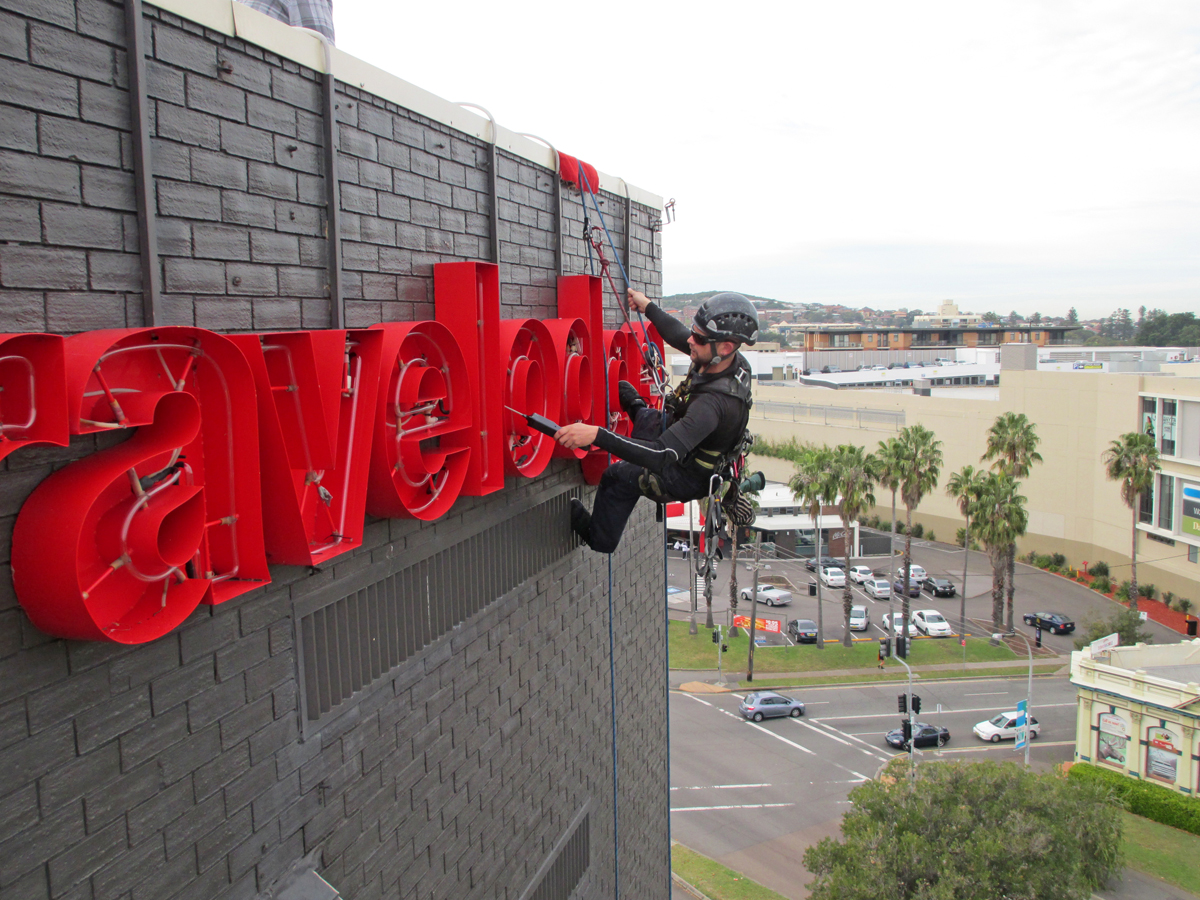Sign installation work ranks among the most conspicuous of all construction operations because it’s typically performed at retail storefronts and other locations adjacent to public streets and highways. Beyond the myriad hazards sign installers face when working at various elevations above the ground, this high visibility accentuates the importance of safe work practices.
The equipment sign companies use to position workers safely and securely thus represents a crucial consideration in the sign installation field. Depending on the size of the company and its available resources, this equipment ranges from portable ladders and scaffolds to crane-mounted or suspended work platforms. Because personal safety is paramount, it’s essential to understand the pros and cons of various types of installation equipment.
LADDERS AND SCAFFOLDS
If your company’s operations are strictly limited to installing relatively small, lightweight signs, ladders and scaffolds might suffice. But it’s crucial to appreciate the limitations and potential hazards of using these devices. Because ladders and scaffolds are designed strictly for worker positioning and not to support signs or related components, the range of operations that can be safely performed using this equipment is quite limited.
In general, any operation that involves heavy lifting, pushing or pulling motions (e.g., operating a masonry drill or changing a large signface panel) is poorly suited to a freestanding ladder or scaffold. Many years ago, I learned about a fatal accident that occurred when sign company workers attempted to install a large signface they had lifted by hand to the top of a free-standing, 40-ft. scaffold. As the two men were moving the face into position, a sudden gust of wind blew up, toppling the scaffold, killing one man and seriously injuring the other. This and other preventable tragedies speak to the crucial importance of adhering to requirements of the Occupational Safety and Health Administration (OSHA) and always using equipment well-suited for the job at hand. A related consideration is that ordinary ladders and portable scaffolds generally are not designed to accommodate the use of fall-protection equipment.

These shortcomings explain why crane-mounted work platforms have become standard equipment today for many sign companies. The principal advantage of these work platforms is that they are controllable from the worker’s position and they enable workers to perform various installation steps with nearly the same degree of safety and confidence they would feel when standing on solid ground. This enhanced worker security also represents substantially improved productivity.
Advertisement
GETTING HIGHER
For projects performed at heights exceeding the reach of ordinary cranes or personnel lifts, other methods might be necessary. For example, high-rise sign installations typically involve the use of large construction-type cranes and suspended work platforms. While this is a safe method compatible with the use of fall-protection gear, it has a couple disadvantages. First, because the suspended worker(s) cannot control movements of the work platform, it’s essential for them to maintain direct visual or voice contact with the crane operator at all times. Secondly, because the work platform is suspended, operations that involve pushing, pulling or lifting will tend to swing the plat-form out of position. While this normally doesn’t pose significant obstacles, work operations may require more time to complete when using suspended platforms. Similarly, because a suspended plat-form can swing slightly from side to side, it’s necessary to prevent the platform from accidentally damaging fragile portions of the sign or wall surface.
Occasionally, even the largest mobile cranes or personnel lifts might not reach certain sign locations. For example, when installing signs atop tall buildings, worker-controlled swing stages suspended from the building roof are commonly used. In cases where a swing stage cannot be used, a worker might rappel over the roof edge, utilizing a bosun’s chair to maintain an upright body position. In general, this is not a desirable option because of the physical demands involved and the very limited range of movement possible. For these reasons, in addition to the heightened level of risk, rappelling is employed only when no other option is feasible for a particular project.
RULES FOR A REASON
Detailed safety requirements for all equipment used in sign installation work are published and periodically updated by OSHA. To protect employees on the job and avoid costly safety violations, it behooves sign company managers and field workers to understand and observe all applicable rules.



 Tip Sheet1 week ago
Tip Sheet1 week ago
 Ask Signs of the Times3 days ago
Ask Signs of the Times3 days ago
 Real Deal1 week ago
Real Deal1 week ago
 Benchmarks5 days ago
Benchmarks5 days ago
 Editor's Note2 weeks ago
Editor's Note2 weeks ago
 Women in Signs1 week ago
Women in Signs1 week ago
 Photo Gallery1 week ago
Photo Gallery1 week ago
 Women in Signs1 week ago
Women in Signs1 week ago









